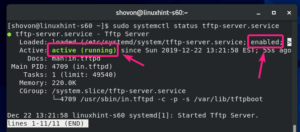
- #Linux tftp server how to
- #Linux tftp server install
- #Linux tftp server software
- #Linux tftp server password
By following this guide, computers on your local network can access your system to store and retrieve files, either via the command line or their preferred FTP client.
#Linux tftp server how to
We also learned how to use the command line or GNOME GUI as an FTP client to connect to the server.
#Linux tftp server software
In this guide, we saw how to use the vsftpd software package to create an FTP server on Ubuntu Linux. For example, adding the following line will instruct vsftpd to listen on port 2121: At the bottom of the file, use the listen_port directive to specify a different port for vsftpd to use. However, we can change this behavior by making a small edit to the /etc/nf file. To connect from command line and verify that everything is working, open a terminal and use Ubuntu’s ftp command to connect to your loopback address (127.0.0.1).īy default, the FTP protocol listens on port 21 for user authentication and port 20 for data transfer.
#Linux tftp server install
It will either install the software or tell you that it already exists on the system. First, ensure that the default FTP client utility is installed on your system by running the following command.

You should now be able to connect to your FTP server either by IP address or hostname. $ sudo bash -c "echo FTP TESTING > /home/ftpuser/FTP-TEST" This file should be visible when we login to FTP in the next steps.
#Linux tftp server password

In this guide, we will go over the step by step instructions to install vsftpd on Ubuntu.

A very popular and highly configurable FTP server package is vsftpd, available for many Linux systems, including Ubuntu. You can even use default GUI and command line tools as an FTP client.

On Ubuntu Linux, there are a multitude of different FTP server and client software packages available. It’s also possible to configure anonymous authorization, which means that users will not need their own account in order to connect to the FTP server. The clients can access a remote directory with their user account, and then download or upload files there, depending on the permissions that have been granted to them. It works by having a server that is listening for connections (on port 21 by default) from clients. Using FTP proves to be a pretty basic task after it has been setup properly. FTP stands for “File Transfer Protocol” and is a great protocol for downloading files from a remote or local server, or uploading files onto the server.


 0 kommentar(er)
0 kommentar(er)
